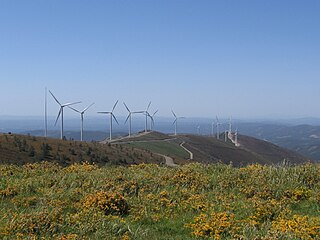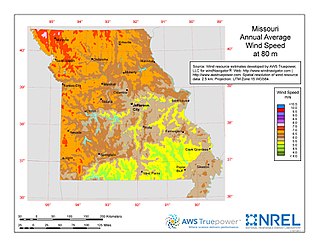
A wind farm or wind park, also called a wind power station or wind power plant, is a group of wind turbines in the same location used to produce electricity. Wind farms vary in size from a small number of turbines to several hundred wind turbines covering an extensive area. Wind farms can be either onshore or offshore.

The electricity sector in Canada has played a significant role in the economic and political life of the country since the late 19th century. The sector is organized along provincial and territorial lines. In a majority of provinces, large government-owned integrated public utilities play a leading role in the generation, transmission, and distribution of electricity. Ontario and Alberta have created electricity markets in the last decade in order to increase investment and competition in this sector of the economy.

Masdar,(Arabic:مصدر), also known as the Abu Dhabi Future Energy Company, is a UAE-government owned renewable energy company based in Abu Dhabi, United Arab Emirates. Masdar is a subsidiary of Mubadala Development Company and was founded by the UAE government in 2006. It is guided by The Abu Dhabi Economic Vision 2030, a program that drives new sources of income for the Emirate and strengthens its knowledge-based economic sectors.

The United Kingdom is one of the best locations for wind power in the world and is considered to be the best in Europe. By the beginning of November 2021, the UK had 11,018 wind turbines with a total installed capacity of over 24.3 gigawatts: 13.9 gigawatts of onshore capacity and 10.4 gigawatts of offshore capacity, the sixth largest capacity of any country in 2019. Wind power contributed 24.8% of UK electricity supplied in 2020, having surpassed coal in 2016 and nuclear in 2018. It is the largest source of renewable electricity in the UK. The UK Government has committed to a major expansion of offshore capacity by 2030.
Finavera Wind Energy Inc. is a former Canadian wind power company, between 2007 and 2017, that owned and operated wind farms in northeastern British Columbia. Headquartered in Vancouver, the company began listing shares on TSX Venture Exchange in 2007 until it was acquired in 2017 by Solar Alliance Energy Inc TSX: SOLR. Formerly named Finavera Renewables Inc., the company develops wind farms in Canada and Ireland. The company was founded in Dublin, Ireland, in 2003. On 4 April 4, 2005, Finavera acquired a 10% stake in the wave energy technology company AquaEnergy Group, and in 2006, it acquired rest of the shares in AquaEnergy. AquaEnergy became a wholly owned subsidiary of Finavera and was renamed Finavera Renewables Ocean Energy. It developed the AquaBuOY wave energy conversion technology with plan to install the converter in Makah Bay off the coast of Newport, Oregon. However, in 2010 Finavera Renewables Ocean Energy was sold and Finavera concentrated to the wind energy.

Wind power is one of the main renewable energy sources in Australia and contributed 10% of electricity supplied in 2020, with 37.5% of total renewable energy supply. Australia has excellent conditions for harvesting wind power with abundant wind resources located close to population centres in the southern parts of the country and on the slopes of the Great Dividing Range in the east.
Wind power has a history in Canada dating back many decades, particularly on prairie farms. As of December 2019, wind power generating capacity was 13,413 megawatts (MW), providing about 6% of Canada's electricity demand. The Canadian Wind Energy Association (CanWEA) has outlined a future strategy for wind energy that would reach a capacity of 55 GW by 2025, meeting 20% of the country's energy needs.

Wind power is a major source of electricity in Portugal. At the end of 2020, wind power capacity in Continental Portugal was 5,456 MW. In 2020, wind power represented 23.7% of total electricity generation.

As of 2019, renewable energy technologies provide about 17.3% of Canada's total primary energy supply. For electricity renewables provide 67%, with 15% from nuclear and 18% from hydrocarbons.
Bluewater Wind is an energy company on the North Atlantic Coast, United States, and in the Great Lakes Region, United States, developing offshore wind energy projects. Bluewater's staff has experience in the wind, energy, environmental, finance, public policy, and marine sectors. Bluewater Wind was part of the Babcock & Brown family of companies. and become part of NRG Energy.
GE Wind Energy is a branch of GE Renewable Energy, a subsidiary of General Electric. The company manufactures and sells wind turbines to the international market. In 2018, GE was the fourth largest wind turbine manufacturer in the world.

Alta Wind Energy Center (AWEC), also known as Mojave Wind Farm, is the third largest onshore wind energy project in the world. The Alta Wind Energy Center is a wind farm located in Tehachapi Pass of the Tehachapi Mountains, in Kern County, California. As of 2013, it is the largest wind farm in the United States, with a combined installed capacity of 1,550 MW (2,080,000 hp). The project, being developed near Tehachapi Pass Wind Farm— site of the first large-scale wind farms installed in the U.S. in the 1970s and 1980s—is "a powerful illustration of the growing size and scope of modern wind projects".
Innergex Renewable Energy is a developer, owner and operator of run-of-river hydroelectric facilities, wind energy, and solar farms in North America. While many of the firm's operational assets are located in its home province of Québec, it has expanded into Ontario, British Columbia, and Idaho.

The great majority of wind turbines around the world belong to individuals or corporations who use them to generate electric power or to perform mechanical work. As such, wind turbines are primarily designed to be working devices. However, the large size and height above surroundings of modern industrial wind turbines, combined with their moving rotors, often makes them among the most conspicuous objects in their areas. A few localities have exploited the attention-getting nature of wind turbines by placing them on public display, either with visitor centers on their bases, or with viewing areas farther away. The wind turbines themselves are generally of conventional horizontal-axis, three-bladed design, and generate power to feed electrical grids, but they also serve the unconventional roles of technology demonstration, public relations, and education.

Wind power in Michigan is a developing industry. The industrial base from the automotive industry has led to a number of companies producing wind turbine parts in the state. The development of wind farms in the state, however, has lagged behind. In January 2021, there were a total of 1,481 wind turbines in the state with a nameplate capacity of 2,549 MW. The nameplate total exceeded 2,000 MW when Pine River came online in March 2019. Wind provided 4.2% of the state's electricity in 2016.

Wind power in Missouri has an installed capacity of 959 MW from 499 turbines, as of 2016. This provided 1.29% of the state's electricity production.











